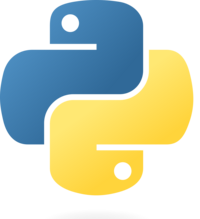Diferencia entre revisiones de «Usuario:Lmorillas/intropyaytozgz/inmersionpython»
De WikiEducator
| (8 revisiones intermedias por el mismo usuario no mostrado) | |||
| Línea 1: | Línea 1: | ||
| + | {{MiTitulo| Inmersión en Python }} | ||
{{#widget:Slides}} | {{#widget:Slides}} | ||
| Línea 84: | Línea 85: | ||
<source lang="python" enclose="div"> | <source lang="python" enclose="div"> | ||
>>> nombre = 'Luis' | >>> nombre = 'Luis' | ||
| − | >>> | + | >>> apellido = "GARCÍA" |
| − | + | >>> ficha = """Nombre: Luis | |
| − | >>> | + | Apellido: GARCÍA""" |
| − | + | >>> print ficha | |
| − | + | Nombre: Luis | |
| − | + | Apellido: GARCÍA | |
| − | + | ||
| − | + | ||
| − | + | ||
| − | + | ||
</source> | </source> | ||
</div> | </div> | ||
<div class="slide"> | <div class="slide"> | ||
| + | |||
=== FORMATO DE CADENAS === | === FORMATO DE CADENAS === | ||
<source lang="python"> | <source lang="python"> | ||
| Línea 102: | Línea 100: | ||
>>> "%s %s" %('hello', 'world') | >>> "%s %s" %('hello', 'world') | ||
'hello world' | 'hello world' | ||
| + | |||
| + | >>> values = {'vegetable': 'chard', 'fruit': 'nectarine'} | ||
| + | >>> 'I love %(vegetable)s and I love %(fruit)s.' % values | ||
| + | 'I love chard and I love nectarine.' | ||
# Nuevo estilo. PEP 3101 | # Nuevo estilo. PEP 3101 | ||
| Línea 109: | Línea 111: | ||
</div> | </div> | ||
<div class="slide"> | <div class="slide"> | ||
| + | === OPERACIONES CON CADENAS === | ||
| + | * http://docs.python.org/2/library/stdtypes.html#string-methods | ||
| + | <source lang="python"> | ||
| + | >>> usuario = "Nombre, Apellido" | ||
| + | >>> usuario.find('Apellido') | ||
| + | 8 | ||
| + | >>> usuario.find('Apellidos') | ||
| + | -1 | ||
| + | >>> usuario.replace('Apellido', 'Apellidos') | ||
| + | 'Nombre, Apellidos' | ||
| + | >>> usuario.upper() | ||
| + | 'NOMBRE, APELLIDO' | ||
| + | >>> " Nombre, Apellido ".strip() | ||
| + | 'Nombre, Apellido' | ||
| + | >>> usuario.split(',') | ||
| + | ['Nombre', ' Apellido'] | ||
| + | </source> | ||
| + | |||
| + | </div> | ||
| + | <div class="slide"> | ||
| + | |||
== Entrada / salida == | == Entrada / salida == | ||
</div> | </div> | ||
<div class="slide"> | <div class="slide"> | ||
=== PRINT === | === PRINT === | ||
| + | <br /> | ||
<source lang="python"> | <source lang="python"> | ||
>>> print "Ayto" | >>> print "Ayto" | ||
| Línea 138: | Línea 162: | ||
<div class="slide"> | <div class="slide"> | ||
=== CONDICIONALES: IF - ELSE === | === CONDICIONALES: IF - ELSE === | ||
| + | <br /> | ||
<source lang="python" enclose="div"> | <source lang="python" enclose="div"> | ||
edad = int(raw_input('Introduce tu edad: ')) | edad = int(raw_input('Introduce tu edad: ')) | ||
| Línea 149: | Línea 174: | ||
<div class="slide"> | <div class="slide"> | ||
=== FOR === | === FOR === | ||
| − | + | <br /> | |
<source lang="python"> | <source lang="python"> | ||
>>> for num in (1, 2, 3): | >>> for num in (1, 2, 3): | ||
| Línea 180: | Línea 205: | ||
<div class="slide"> | <div class="slide"> | ||
=== RANGE === | === RANGE === | ||
| − | + | <br /> | |
<source lang="python" enclose="div"> | <source lang="python" enclose="div"> | ||
>>> range(5, 10) | >>> range(5, 10) | ||
| Línea 206: | Línea 231: | ||
<div class="slide"> | <div class="slide"> | ||
=== BREAK, CONTINUE, ELSE === | === BREAK, CONTINUE, ELSE === | ||
| − | + | <br /> | |
<source lang="python" enclose="div"> | <source lang="python" enclose="div"> | ||
>>> for n in range(2, 10): | >>> for n in range(2, 10): | ||
| Línea 254: | Línea 279: | ||
<div class="slide"> | <div class="slide"> | ||
=== LISTAS === | === LISTAS === | ||
| − | Secuencias ordenadas. Dinámicas. Acceso por índice. Heterogéneas. Corchetes. | + | * Secuencias ordenadas. |
| + | * Dinámicas. | ||
| + | * Acceso por índice. | ||
| + | * Heterogéneas. | ||
| + | * Corchetes. | ||
| + | <source lang="python" > | ||
| + | >>> [11, 22, 33] | ||
| + | >>> ['aa', 'bb', 'cc', ] | ||
| + | >>> [100, 'manzana', 200, 'banana', ] # Última coma opcional | ||
| + | </source> | ||
| + | |||
| + | </div> | ||
| + | <div class="slide"> | ||
| + | ===OPERACIONES CON LISTAS=== | ||
<source lang="python" > | <source lang="python" > | ||
notas = [8, 7, 4.5, 6] | notas = [8, 7, 4.5, 6] | ||
| Línea 263: | Línea 301: | ||
</div> | </div> | ||
<div class="slide"> | <div class="slide"> | ||
| + | |||
=== TUPLAS === | === TUPLAS === | ||
Estáticas. Paréntesis. | Estáticas. Paréntesis. | ||
| + | <source lang="python"> | ||
| + | months = ('January','February','March','April','May','June',\ | ||
| + | 'July','August','September','October','November',' December') | ||
| + | usuario = ('Luis Martínez', 24, True) | ||
| + | </source> | ||
</div> | </div> | ||
<div class="slide"> | <div class="slide"> | ||
